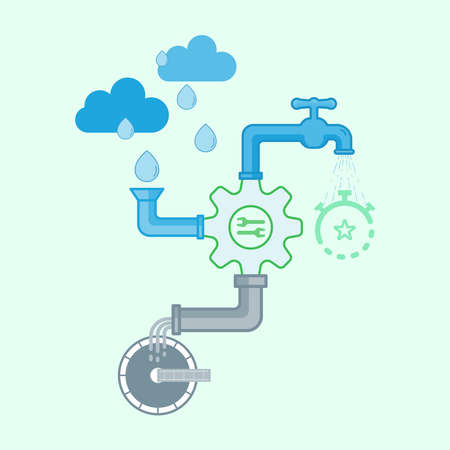Introduction to Rainwater Harvesting in the UK
In recent years, rainwater harvesting has emerged as a crucial practice for greenhouse cultivation across the United Kingdom. With unpredictable weather patterns and increasing concerns about water scarcity, British growers are turning to sustainable solutions that not only reduce their reliance on mains water but also promote environmentally conscious horticulture. The British climate, characterised by regular rainfall interspersed with occasional dry spells, provides both opportunities and challenges for greenhouse irrigation. By capturing and reusing rainwater, growers can ensure a more resilient water supply, lower operational costs, and support the nation’s commitment to sustainability. As interest in local food production rises and environmental regulations tighten, integrating effective rainwater harvesting systems into greenhouse management is becoming an essential strategy for commercial growers and hobbyists alike.
2. British Climate Considerations and Water Scarcity
The United Kingdom is renowned for its variable weather patterns, but this reputation can be misleading when it comes to the realities faced by greenhouse horticulturists. While many associate the British Isles with persistent rainfall, regional disparities and seasonal variations mean water scarcity is a real concern—particularly in the South East and East of England. The following table outlines average annual rainfall across key regions:
| Region | Average Annual Rainfall (mm) |
|---|---|
| South East England | 650 |
| East of England | 620 |
| North West England | 1,300 |
| Scotland (West Coast) | 3,000+ |
This variation often leads to periods of drought that can impact horticultural productivity. The UK has experienced notable dry spells in recent decades, with hosepipe bans and restrictions on water usage affecting both domestic gardeners and commercial growers. For greenhouse operators, such unpredictability makes water-efficient strategies not just prudent, but essential for sustainability.
Necessity for Water-Efficient Horticulture
With climate models predicting longer and more frequent dry periods in the coming years, there is mounting pressure on growers to adopt practices that conserve water without compromising crop yield or quality. This includes investing in rainwater harvesting systems that capture and store precipitation during wetter months for use during drier periods. Furthermore, employing sustainable irrigation methods—such as drip irrigation or automated moisture sensors—can drastically reduce waste and ensure plants receive only the water they require.
Regional Adaptation Strategies
Differentiating irrigation approaches based on local climate data is crucial. For example, growers in the South East may need larger storage tanks or more sophisticated filtration systems due to extended dry spells, whereas those in wetter regions might focus on efficient collection and prevention of overflow.
Key Takeaways for British Greenhouses
- Understanding regional rainfall patterns informs system design.
- Water scarcity is a growing concern even in traditionally ‘wet’ Britain.
- Sustainable irrigation technologies are vital for long-term resilience.
By tailoring water management strategies to the unique demands of the British climate, greenhouse operators can safeguard both their crops and environmental resources.

3. Designing Rainwater Collection Systems for Greenhouses
Setting up an efficient rainwater harvesting system in a British greenhouse requires careful planning to suit both the local climate and typical greenhouse structures found across the UK. By integrating well-designed guttering, storage tanks, and filtration units, growers can reliably collect and use rainwater for sustainable irrigation throughout the year.
Guttering: The First Step to Efficient Water Capture
Begin by installing high-quality gutters along the greenhouse roof edges. Choose robust materials such as PVC or galvanised steel that can withstand the unpredictable British weather. Ensure gutters are sized appropriately—generally, a 76mm (3-inch) diameter is sufficient for most small- to medium-sized greenhouses—and are angled slightly towards the downpipe to facilitate smooth water flow. Secure brackets every 60cm to prevent sagging under heavy rainfall, which is not uncommon in many UK regions.
Storage Tanks: Maximising Capacity and Placement
Select storage tanks with enough capacity to accommodate your expected rainfall and irrigation needs. For small domestic greenhouses, a 200-500 litre water butt may suffice, while larger or commercial operations might require several linked tanks totalling thousands of litres. Position tanks on stable, level ground near the greenhouse for easy access, and consider using opaque or UV-resistant materials to inhibit algae growth—a frequent concern in damp British conditions. Where space allows, slimline tanks can be tucked alongside the greenhouse without impeding pathways or access.
Filtration Systems: Ensuring Water Quality
To protect plants and irrigation equipment from debris and contaminants, fit mesh guards over gutters and downpipes to capture leaves and twigs. Install a first-flush diverter on the downpipe: this clever device discards the initial runoff—often containing dust or bird droppings—before allowing cleaner water into your main tank. For added peace of mind, simple sand or cartridge filters can be installed between the tank and your irrigation system, ensuring only clean water reaches your crops.
Considerations for British Greenhouse Structures
British greenhouses come in various shapes and sizes—from traditional Victorian timber frames to modern aluminium models. Tailor your rainwater collection setup to match the structure; lightweight greenhouses may need extra bracing for guttering, while heritage models might benefit from discreet installations that preserve their character. Always check local planning rules if you are modifying listed buildings or shared allotment sites.
Maintenance: Keeping Systems Running Smoothly
Regular maintenance is key to long-term efficiency. Clear gutters of moss and leaves at least twice yearly—especially after autumn leaf fall—and inspect all fittings for leaks or blockages. Clean filters periodically according to manufacturer instructions, and check that tanks remain sealed against insects and light ingress. With these measures in place, your rainwater harvesting system will provide reliable, eco-friendly irrigation tailored perfectly for British greenhouse gardening.
4. Sustainable Irrigation Methods for Greenhouse Crops
Efficient water management is crucial for British greenhouse growers striving to balance sustainability, productivity, and resource conservation. Integrating rainwater harvesting with modern irrigation solutions helps optimise water use while reducing reliance on mains supply. Below, we analyse several irrigation technologies—drip irrigation, capillary matting, and automated watering systems—highlighting their suitability for UK conditions.
Drip Irrigation
Drip irrigation delivers water directly to plant roots through a network of tubing and emitters. This method minimises evaporation and run-off, making it highly efficient for both small hobbyist greenhouses and larger commercial operations. Drip systems are particularly effective when paired with harvested rainwater, as they allow precise control over the volume and timing of irrigation. In the UK’s often variable climate, drip irrigation ensures consistent moisture levels without saturating the soil, reducing the risk of root diseases.
Capillary Matting
Capillary matting is an ideal solution for bench-grown crops or seed trays. The mats absorb water from a reservoir below and distribute it evenly through capillary action, allowing plants to draw up moisture as needed. This approach reduces water waste and provides a steady supply of hydration—especially useful during unpredictable weather or for growers aiming to minimise manual intervention. While not suitable for all crop types, capillary matting excels in propagation areas and with shallow-rooted species common in British greenhouses.
Automated Watering Solutions
Automation has become increasingly popular among UK growers seeking greater efficiency and control over irrigation routines. Automated systems range from simple timers attached to hoses to sophisticated sensors that monitor soil moisture and climate conditions. These solutions can be integrated with rainwater storage tanks, ensuring that only collected rainwater is used during scheduled watering cycles. Automation helps mitigate labour demands and eliminates guesswork, leading to more uniform crop growth and better resource management.
Comparative Analysis of Irrigation Methods
| Irrigation Method | Water Efficiency | Labour Requirement | Suitability for Rainwater Use | Best Suited Crops/Settings |
|---|---|---|---|---|
| Drip Irrigation | High | Low (once set up) | Excellent | Fruit/veg crops; mixed planting beds |
| Capillary Matting | Moderate-High | Low-Medium | Good | Seedlings; potted plants; propagation areas |
| Automated Systems | Variable (depends on system) | Very Low (after installation) | Excellent (with integration) | Larger greenhouses; commercial settings; mixed crops |
Choosing the Right System for Your Greenhouse
The optimal irrigation method depends on the scale of your greenhouse, crop type, labour availability, and integration with existing rainwater harvesting infrastructure. Most British growers benefit from combining two or more methods—for example, using capillary mats for seedlings alongside automated drip lines for mature crops—to achieve maximum efficiency and sustainability.
5. Maintenance, Legislation, and Best Practices
Routine Care for Rainwater Harvesting and Irrigation Systems
To ensure rainwater harvesting and sustainable irrigation systems in British greenhouses operate efficiently, regular maintenance is essential. This includes clearing gutters of debris, inspecting filters and first-flush diverters, checking for leaks in storage tanks and pipework, and cleaning pumps and irrigation lines to prevent blockages. Scheduled inspections—ideally at the start of each growing season and after major storms—help identify potential issues before they escalate. Keeping a simple maintenance log can assist growers in tracking servicing tasks and system performance over time.
Relevant UK Water Regulations
Rainwater harvesting systems in the UK must comply with legislation set out by bodies such as the Environment Agency and local water authorities. The Water Supply (Water Fittings) Regulations 1999 require proper separation between harvested rainwater and mains supply to avoid contamination risks. Backflow prevention devices are mandatory when integrating systems with mains-fed components. Any installation that involves significant groundworks or discharge to watercourses may need additional permits under the Environmental Permitting Regulations. Staying informed about updates from DEFRA or your local council ensures ongoing compliance.
Best Practices for Optimal Performance and Compliance
- Install easily accessible inspection points for tanks and filters to facilitate routine checks.
- Use signage to clearly distinguish non-potable rainwater outlets from potable supplies within the greenhouse.
- Regularly test stored rainwater for quality, especially if used on edible crops, to guard against pathogens.
- Choose materials for tanks, pipes, and fittings that are robust against British weather conditions and resistant to algae growth.
- Engage qualified professionals for initial system design and complex repairs to meet regulatory standards.
Summary
A proactive approach to maintenance, a clear understanding of UK legislation, and adherence to industry best practices will support reliable, sustainable irrigation in British greenhouses while safeguarding legal compliance and crop safety.
6. Environmental and Economic Benefits
Implementing rainwater harvesting and sustainable irrigation systems in British greenhouses offers a wealth of long-term environmental and economic advantages. By reducing reliance on mains water, greenhouse operators can significantly cut their operational costs, particularly as water prices continue to rise across the UK. In addition, utilising rainwater helps minimise stormwater runoff, which in turn mitigates localised flooding and decreases the burden on municipal drainage systems—a critical consideration in many urban and rural British communities.
From an environmental perspective, sustainable irrigation methods such as drip or subsurface systems ensure that every drop of harvested rainwater is used efficiently, directly benefitting plant health while drastically reducing water wastage. This not only conserves precious freshwater resources but also limits the use of energy required for pumping and treating mains water, resulting in lower greenhouse gas emissions.
Long-Term Sustainability
For British greenhouse growers, investing in these integrated systems means building resilience against increasingly unpredictable weather patterns linked to climate change. As droughts become more frequent and rainfall becomes less reliable, the ability to store and manage rainwater ensures a steady supply for crops year-round. Over time, this fosters greater food security and supports the transition towards low-impact horticultural practices that are vital for future-proofing the industry.
Cost Savings Over Time
Although initial installation requires capital investment, the ongoing savings from reduced water bills and potential government incentives make rainwater harvesting financially attractive in the medium to long term. Furthermore, maintaining healthy soil moisture through targeted irrigation minimises plant stress, leading to higher yields and better-quality produce—both key factors in enhancing profitability for British growers.
Positive Environmental Impacts
The cumulative environmental benefits are substantial: improved biodiversity around water collection points, reduced demand on overstretched water supplies, and a demonstrable reduction in carbon footprint. For forward-thinking greenhouse owners across Britain, embracing these technologies is a practical step towards meeting national sustainability targets while strengthening their business models in an ever-changing climate.


